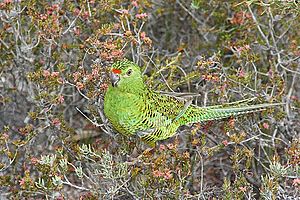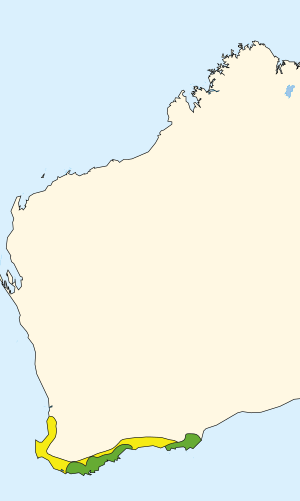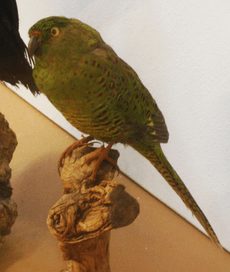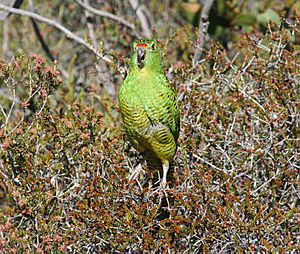Western ground parrot facts for kids
Quick facts for kids Western ground parrot |
|
|---|---|
 |
|
| Scientific classification | |
| Genus: |
Pezoporus
|
| Species: |
flaviventris
|
 |
|
| Yellow plus green is historic range, green is current remaining range | |
The western ground parrot (Pezoporus flaviventris) is a very rare type of parrot. It lives only in Western Australia. This bird is a close relative of the eastern ground parrot and the mysterious night parrot. It is one of the rarest birds in the world, with only about 150 left.
The Noongar people, who are the traditional owners of the land, call this parrot kyloring.
This parrot looks a lot like the eastern ground parrot. However, the feathers on its belly and under its tail are bright yellow with faint black stripes. Young western ground parrots are grey-brown around their heads, wings, and backs. Eastern ground parrots, when young, are bright green in these areas. This grey-brown color helps young western ground parrots hide better in their dry, open homes in southwest Australia. Eastern ground parrots live in thick plants with less open ground.
Scientists have studied the DNA of these birds. They believe the western ground parrot separated from the ground parrots in eastern Australia about 2 million years ago.
Contents
What is Taxonomy?
Taxonomy is how scientists name and group living things. The western ground parrot was first described as its own species in 1911 by Alfred John North. He noticed its unique feathers. North compared parrots from Western Australia that were collected in the 1860s.
The name flaviventris comes from Latin words. Flavus means "golden-yellow" and venter means "belly." This describes the parrot's yellow belly.
Later, some scientists thought it was just a type of eastern ground parrot. But in 2010, a new study looked at its genes. This study showed that it is indeed a different species. The third species in this group is the rare night parrot.
What Does It Look Like?
The western ground parrot looks similar to the eastern ground parrot. But its belly feathers and the feathers under its tail are bright yellow. They also have faint black stripes.
Young western ground parrots are mostly grey-brown. Young eastern ground parrots, however, are bright green. This difference helps them blend into their different environments.
Where Do They Live?
In the past, these parrots lived all along the coast of southwest Australia. They were found from Perth north to Geraldton and east to Israelite Bay. But by 1900, they had disappeared from the west coast.
Today, the western ground parrot lives in only two places along the south coast of Western Australia. These areas are east of Albany. The biggest group lives in Cape Arid National Park.
They usually live in low, bushy areas called heathland. These areas often have deep white sand and many different types of plants. The parrots seem to prefer heathland that has not burned for many years. But they can also be found in areas that burned six years ago. Their habitat often has many sedges, which are grass-like plants.
How Rare Are They?
The western ground parrot is one of the rarest birds in the world. In 2004, the first photo of this parrot in the wild was taken. Between 1990 and 2009, their numbers dropped quickly. They went from about 400 birds to only 110. Most of these birds (around 100) live in Cape Arid National Park.
The Australian Government lists this parrot as "critically endangered." This means it is at very high risk of disappearing forever. The biggest dangers to these parrots are:
- Introduced predators: Animals like foxes and wild cats hunt them.
- Wildfires: Big fires can burn their homes and kill the birds.
Also, a plant disease called Phytophthora cinnamomi dieback affects many plants in their habitat. It is not clear how losing these plants might affect the parrots. Sadly, it is believed that fewer than 40 parrots are left today.
In November 2015, huge bushfires near Esperance burned almost all of the western ground parrot's home. The effect on the remaining birds is still unknown.
Behaviour
Western ground parrots usually search for food alone or with one other bird. It is very hard to see them because they rarely fly or make sounds during the day. They usually stay hidden among low plants. Their feathers help them blend in perfectly.
If something scares them, they will fly low over the plants. Then they land again about 100 meters away. When they fly after being scared, they move in a zigzag pattern. They have short gliding parts and flap their wings very fast.
They mostly make sounds at dusk (evening) and early morning before the sun comes up. Their call is a high-pitched sound that can be heard from far away. Other parrots nearby will answer these calls.
What Do They Eat?
Western ground parrots eat seeds from many different plants, especially sedges. For example, they eat seeds from Mesomaelaena stygia. They also eat flower buds and the base of flowers from plants like beaufortias, dryandras, and grevilleas. One parrot was even seen eating the juicy leaves of Daviesia pachyphylla. Their diet is varied because their habitat has so many different plants.
Reproduction and Life Cycle
In November 2018, a western ground parrot nest was found in Cape Arid National Park. This was the first new nest found since 1913! The nest was found during fieldwork by the Department of Parks and Wildlife.
In 1913, F. Lawson Whitlock described a nest as a small dip in the ground. It was hidden among low, spiky plants, possibly a type of Hakea. This nest was on a low ridge.
Young parrots, called fledglings, have been seen from September to November. Male parrots feed the females on the ground in special "mate-feeding areas." The male arrives quietly just after dark. The female asks for food by making a short, rough begging sound.
On hot, dry days, the male parrot can have trouble feeding the female. This is because he does not drink water during the day. He gets his water from the plants he eats. So, when it's hot, the food in his crop (a pouch in his throat) can become thick and hard to bring up. As the nesting time goes on, the female becomes very insistent. She might even chase the male if he stops feeding her.
After feeding his mate, the male usually makes a loud call and moves a short distance away. The female then leaves the area quietly. The male might sleep near this spot. The actual nest can be quite far from this feeding area, sometimes as much as 400 meters (1300 feet) away.
The female can lay up to five eggs in a small dip within a clump of low plants. She lines the nest with plant material.
A possible empty nest was found in 1989 by Ray Garstone. While old, unburnt habitat is important for nesting, the parrots often nest near younger, recently burnt areas. These younger areas can offer more and different types of food.
Western ground parrots are among the few parrots that nest on the ground. Their young leave the nest before they can fly well. They can only make short, wobbly flights. These young birds have only been seen twice in the last 90 years. After leaving the nest, it is believed the male parrot takes care of the young.
In July 2014, seven critically endangered western ground parrots were moved to the Perth Zoo. This was done by the Department of Parks and Wildlife. It is hoped that these parrots will breed at the zoo to help increase their numbers.
See also
 In Spanish: Perico terrestre oriental para niños
In Spanish: Perico terrestre oriental para niños




